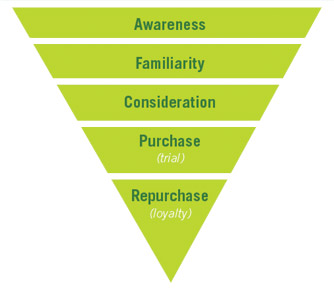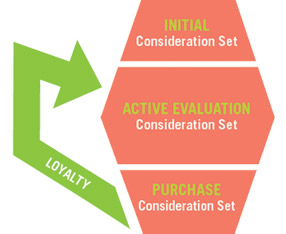Why do customers do what they do? What goes through someone’s mind when they’re thinking about a purchase? Why do people choose one product over another? These are all good questions. Customer and potential customer behavior is not an exact science. But we do know quite a bit about what makes them tick. And we certainly know the process they go through before they actually buy a product.
Consumer purchase decisions have changed drastically over the last 10 years. With communication and information literally flowing at the speed of light, consumers can get product information anytime, anywhere. And they can get a lot of it in a matter of minutes. Yes, it’s a cliché way to put it, but when it comes to consumer purchase decision-making – the internet changed everything.
TRADITIONAL MODEL OF CONSUMER BEHAVIOR
 The traditional model of consumer purchase behavior is represented by a funnel shape, with the largest population of potential purchase options signified by the top, or widest part, of the funnel with the field of choices narrowing as the consumer goes through a linear decision-making process.
The traditional model of consumer purchase behavior is represented by a funnel shape, with the largest population of potential purchase options signified by the top, or widest part, of the funnel with the field of choices narrowing as the consumer goes through a linear decision-making process.
Under this pattern, marketers have long attempted to reach the consumer to impact the awareness and familiarity stages of this funnel, using advertising and other media placement to convince the consumer to include their brand in a “considered set” when a purchase requirement is triggered and following with package design, promotion, store/service environment and point-of-sale messaging as a final push tactic once the consumer has narrowed the field to a few choices.
FLAW #1: While creative advertising will still get noticed by an interested consumer, the explosion of products, services and media outlets in the past 25 years has created a clutter of messaging that the human mind just can’t process. It is estimated in this time period that the average number of marketing messages a consumer receives daily has almost doubled – to almost 7,000 per day.
FLAW #2: In addition to the assumption that the consumer can be receptive to all of the ongoing exposure, the funnel model also treats the consumer as passive until the consideration stage, by which time the belief has been that they have already eliminated a large number of purchase options.
FLAW #3: After the initial connection between a brand promise and brand experience (trial purchase) some also consider “the funnel” to imply that the population of brands from which a consumer creates a longer-term commitment (repurchase) to be limited to those brands residing in their original considered set, again treating the consumer as way too passive.
HELLO NEW MODEL
 A new study by McKinsey & Co., the first quantified analysis that we have seen to challenge the funnel model, finds that increasingly informed and empowered consumers:
A new study by McKinsey & Co., the first quantified analysis that we have seen to challenge the funnel model, finds that increasingly informed and empowered consumers:
- Begin with a much narrower list of purchase options and perceptions, based on what they have stored in their brains for later recall.
- Expand their consideration set considerably during a phase of active evaluation, paying attention to relevant advertising, shopping, researching reviews and opinions on the Internet and seeking out recommendations or related experience from friends and family.
- Are not as methodical as previously thought and often enter a store or purchase environment with a much larger list of possible options than the funnel model represents.
- Often aren’t as loyal as marketers want to believe, actively considering options during a post-purchase experience and becoming much more receptive to ongoing competitive exposure.
WHAT DO THESE FINDINGS MEAN TO MARKETERS?
- First, company-driven messaging through advertising must be targeted. More is not always better. You must understand the purchase decision process of your potential consumer and reach them with relevancy while they are in the stage of active evaluation.
- Your brand or company must have a high-quality, informative and interactive website and you must engage in social media, developing ways for consumers to learn about you, talk to you and talk about you. Work with independent sites that follow your brand and monitor what is being said about your brand.
- Next, you must spend more time creating a positive delivery point – whether it is your store, a retailer that carries your product, a service outlet, your office, your presentation when calling on clients … even those environments such as a warehouse or a bill paying desk … EVERY customer touch point can and will be evaluated by the consumer.
- Finally, find ways to reward and promote loyalty. Affinity programs and frequent customer rewards keep your customers from wandering after initial customer capture.
Now companies have two choices. They can sit back and live in the old model of customer behavior and continue to throw their marketing dollars in the toilet. Or, embrace the changes of the last decade and design a marketing program that’s more targeted and efficient – leading to better customer loyalty and a greater ROI. Which sounds better for your company? GOOD CHOICE.


